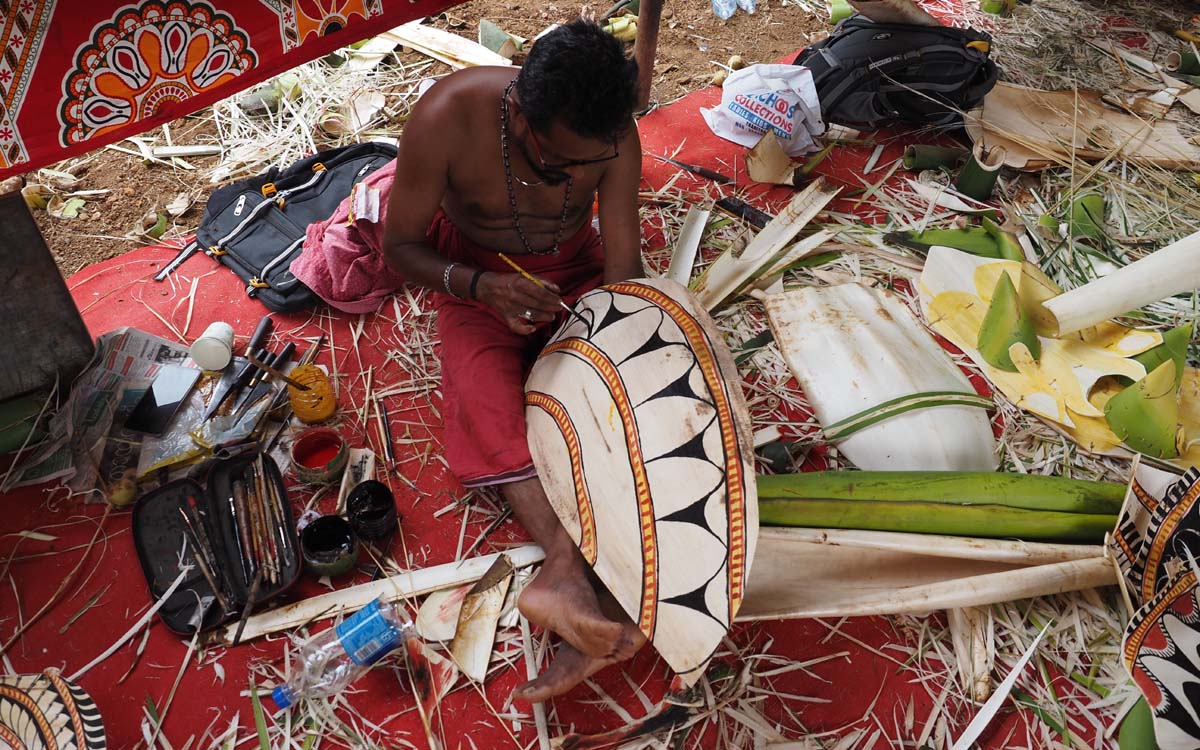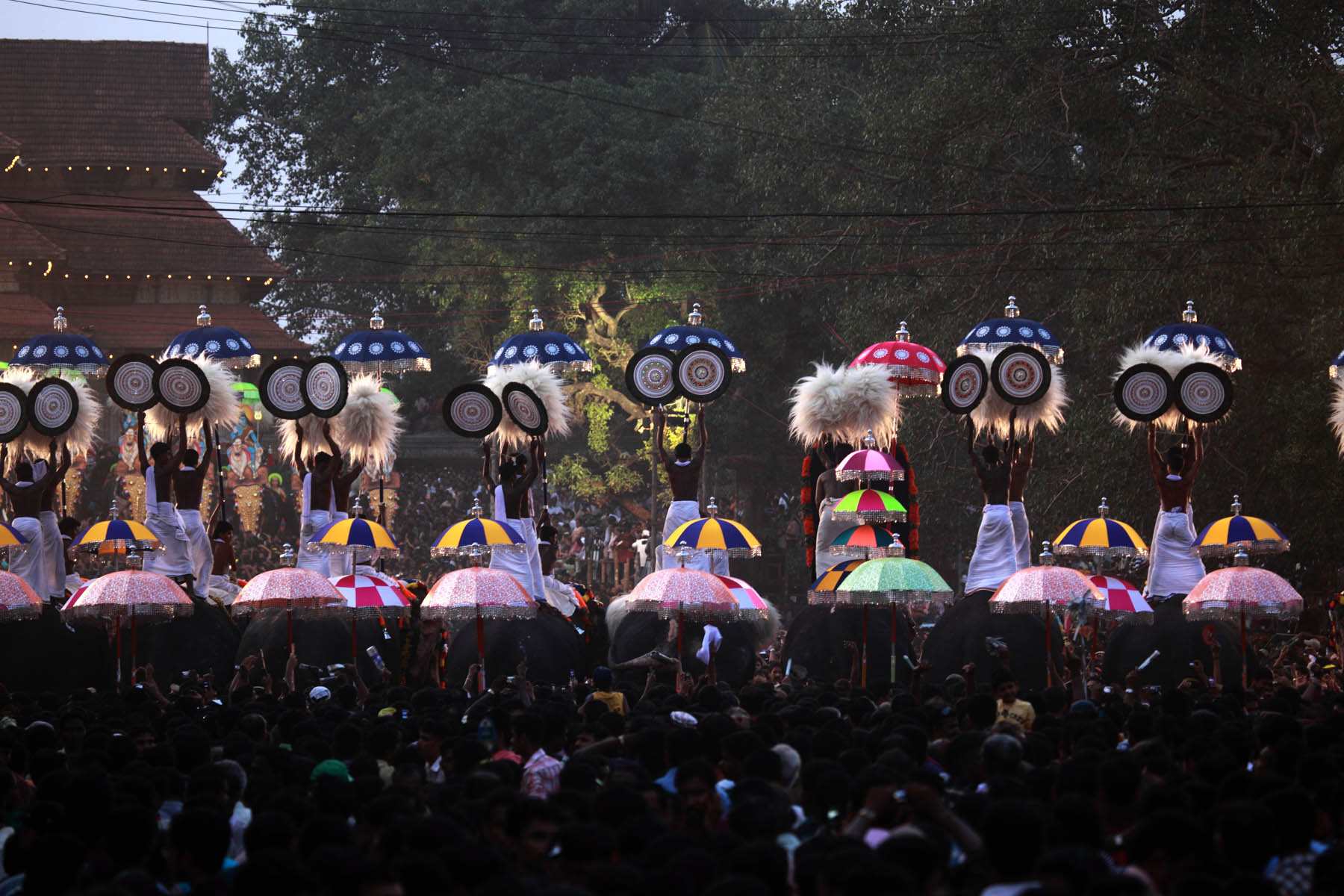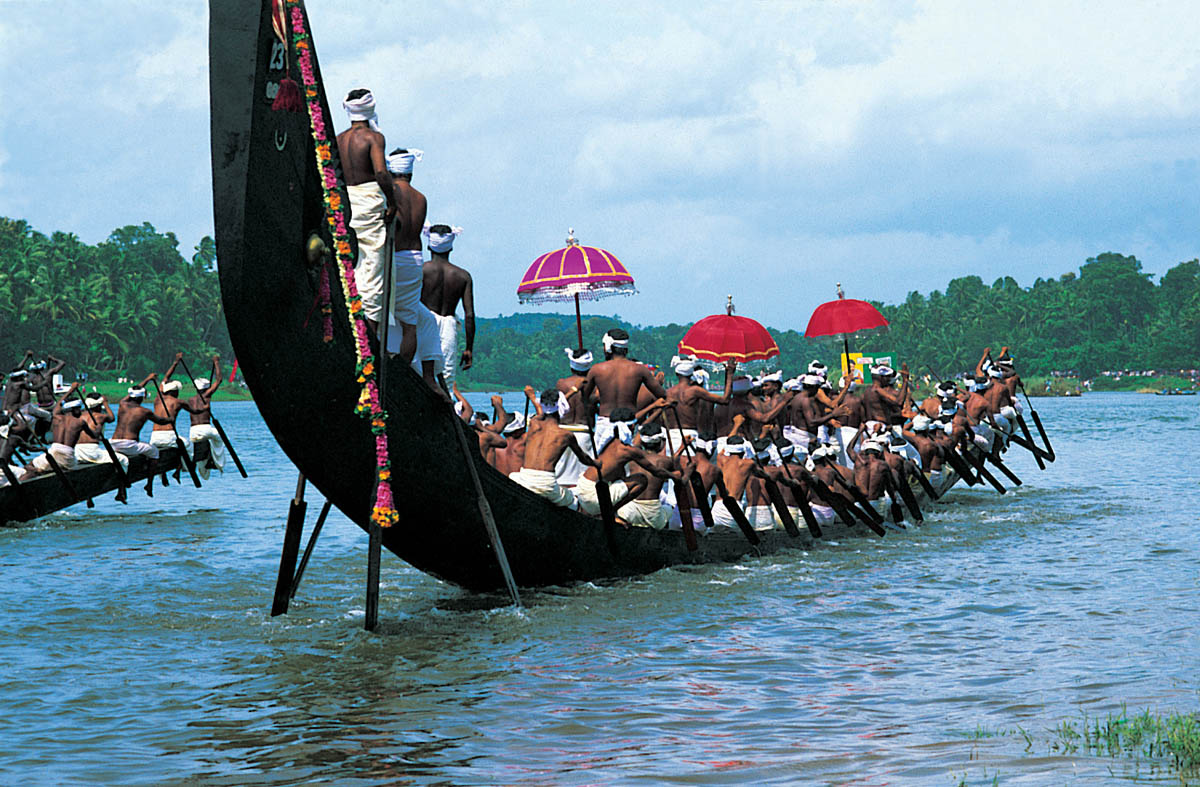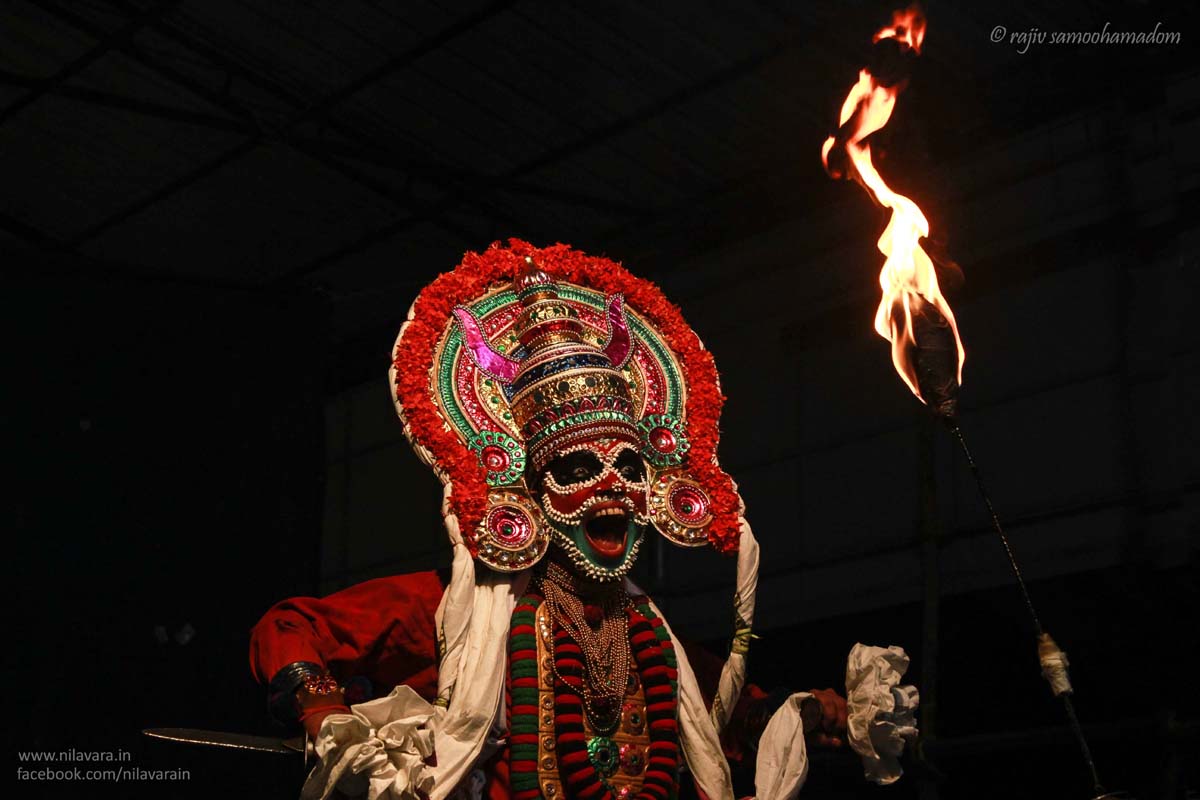Explore Kerala's Vibrant Traditions

Onam
Onam is Kerala’s harvest festival, rooted in agrarian traditions and the legendary return of King Mahabali. It features floral designs (Pookkalam), traditional feasts (Onasadya), and folk games that strengthen social bonds across communities.
Learn More
Theyyam
Theyyam is a ritual performance from North Kerala where performers transform into deities through costume, makeup, and trance. It combines dance, music, and ancestral worship in temple courtyards and sacred groves.
Learn More
Padayani
Padayani is a ritual art form of Central Kerala, known for its rhythmic dances and vibrant Kolams—giant masks painted on areca palm sheaths. It is performed in Bhadrakali temples as part of annual festivals.
Learn More
Thrissur Pooram
Known as the 'Mother of All Poorams', Thrissur Pooram is a grand temple festival held in the heart of Kerala. It showcases synchronized percussion ensembles, majestic elephant processions, and a vibrant cultural gathering that reflects communal harmony.
Learn More
Vallam Kali
Vallam Kali, the traditional boat race of Kerala, is a spirited water sport held during the monsoon season. With snake boats slicing through the backwaters to rhythmic rowing chants, it reflects communal harmony and festive enthusiasm.
Learn More
Mudiyettu
Mudiyettu is a ritualistic dance-drama of Kerala performed in Bhadrakali temples, depicting the battle between the goddess Kali and the demon Darika. Recognized by UNESCO as an Intangible Cultural Heritage, it blends music, dance, and vibrant costumes to convey mythological stories and community values.
Learn MoreKerala Folklore: Unveiling Ancient Wisdom, Community Bonds, and Human Spirit
Folklore stands as a fundamental and universal aspect of human expression, encompassing the traditional beliefs, customs, stories, songs, and practices that define a community. It represents a rich compilation of the mores and practices of distinct cultural groups, serving as a repository of shared human experience. Unlike formal educational settings, folklore is primarily transmitted through informal channels such as oral traditions, group ceremonies, individual tutoring, and children's play. This informal transmission underscores its organic integration into daily life, making it a living, breathing component of cultural heritage.
A common misconception confines folklore to groups defined by shared history, ethnicity, or religion. However, a deeper understanding reveals that folklore represents a shared set of beliefs that can emerge within any kind of shared culture. In contemporary society, this means that even modern professional groups, such as computer programmers, stage actors, or surfers, develop their own unique lore and traditions. This broad perspective highlights that folklore is an intrinsic human mechanism for establishing group identity, transmitting knowledge, and fostering shared understanding, irrespective of whether the group is traditional or modern, geographically bound or professionally aligned. This pervasive human need for shared expression and cultural transmission forms a robust foundation for understanding the specific richness of Kerala folklore.
Kerala, often referred to as "God's Own Country," is a land where a unique blend of diverse influences—including Hinduism, Christianity, Islam, and numerous castes, subcastes, and tribal communities—has converged to create an exceptionally rich and multifaceted folklore. This is not a static collection of historical artifacts but a dynamic, evolving tradition, continuously shaped by its people, their daily lives, and their interactions. It functions as a dynamic cultural force, constantly adapting and reflecting the societal changes around it.
This website distinguishes itself by exploring folklore not merely as cultural expressions but through its profound social and psychological dimensions. This approach delves into how traditional practices within Kerala's folklore address collective well-being, facilitate conflict resolution, and foster mental harmony within communities, offering insights into the human condition. For instance, traditional rituals have historically provided culturally sanctioned remedies for individual and collective mental unrest, leveraging indigenous knowledge systems for holistic well-being. By foregrounding these social and psychological aspects, this platform positions itself beyond a conventional cultural archive, transforming into a specialized resource that investigates the functional, therapeutic, and community-sustaining roles of folklore. This analytical focus elevates the content from purely descriptive accounts to insightful and functionally relevant explorations, establishing a distinct value proposition for the website.
The Journey of Lore: Evolution of Folklore Studies
The concept of folklore has undergone significant transformation, evolving from ancient oral traditions to a recognized modern academic discipline. Prior to the advent of modern societies, oral tradition served as the primary and most vital method for transferring knowledge, stories, and cultural practices across generations. This informal system ensured the continuity of communal wisdom and identity. A significant shift occurred with the rise of print culture and, later, digital media, which enabled folklore to spread across wider regions and cultures, often undergoing modifications in the process. This expansion allowed for broader dissemination but also introduced new dynamics of adaptation and reinterpretation.
The formal academic study of folklore, known as folkloristics, began to distinguish itself as an autonomous discipline during the period of romantic nationalism in 18th-19th century Europe. Influential figures such as Johann Gottfried von Herder, whose writings in the 1770s presented oral traditions as organic processes deeply rooted in local contexts, laid foundational groundwork. Herder's approach was subsequently adopted for nation-building efforts in regions like Germany, Finland, Estonia, and Hungary, where recorded folk traditions were systematized to forge collective cultural identities. The renowned "Kinder- und Hausmärchen" (Children's and Household Tales) by the Brothers Grimm, first published in 1812, stands as the best-known early collection of verbal folklore from the European peasantry. It is important to note that early folklorists often distinguished between "low" or peasant culture and the "high" culture of the aristocracy, sometimes reflecting a class superiority in their collection efforts. Throughout the 19th century, the focus remained largely on the oral folklore of rural peasant populations, often viewed as "residues and survivals of the past" existing within the lower strata of society. This initial alignment of the fledgling discipline was primarily with literature and mythology.
The field experienced key milestones and significant shifts in its understanding of folklore's scope. Antti Aarne developed the first systematic classification of folktales in 1910, later revised by Stith Thompson into the Aarne-Thompson Classification system.1 Vladimir Propp's seminal work, "The Morphology of the Folktale" (1928), further advanced structural analysis by establishing seven broad character types and 31 typical narrative functions in Russian folktales. By the turn of the 20th century, the field's scope expanded significantly, moving beyond just tales and songs to encompass a broader range of cultural expressions, including games, skill sets, crafts, and customs. Folklore became increasingly categorized by the "end product" of the folkloric performance, leading to common categories like Verbal Folklore, Material Artifacts, Customs and Beliefs, and Childlore.
A notable divergence emerged between European and American folklorists. European scholars continued to focus on the oral folklore of homogenous peasant populations within their regions, while American folklorists, led by Franz Boas and Ruth Benedict, chose to consider the totality of customs and beliefs within Native American cultures in their research. This distinction aligned American folkloristics more closely with cultural anthropology and ethnology, utilizing similar data collection techniques in field research. This divided alliance between the humanities in Europe and the social sciences in America continues to offer a wealth of theoretical vantage points and research tools to the field as a whole. The widespread adoption of the term "folkloristics" (along with "folklore studies") in the 1950s clearly distinguished the academic study of traditional culture from the folklore artifacts themselves. A pivotal moment arrived with the American Folklife Preservation Act (Public Law 94-201), passed in 1976, which marked a coming of age for folkloristics in the United States. This legislation recognized cultural diversity as a national strength and a resource worthy of protection, paradoxically viewing it as a unifying feature rather rather than something that separates citizens.2 It articulated a vision of cultural diversity as a "marketplace teeming with the exchange of traditional forms and cultural ideas".
This historical progression signifies a fundamental paradigm shift within folklore studies. It moved from a purely archival or nostalgic perspective, akin to "salvage anthropology," to a sophisticated functionalist and structuralist understanding of how folklore actively shapes and reflects ongoing social realities. This includes its manifestation in modern phenomena like digital folklore, such as memes and urban legends. Today, related fields such as ethnology and cultural anthropology recognize that all social groups, including families, schoolmates, co-workers, and co-hobbyists, possess their own unique folklore. This dynamic perspective allows for the presentation of rich traditions not as mere historical relics, but as living, evolving systems that are profoundly relevant and influential in contemporary society.
Beyond Stories: Folklore's Profound Role in Society
Folklore's significance extends far beyond mere entertainment or historical accounts; it plays a profound and multifaceted role in the fabric of human society. It serves as a vital storehouse of a community's shared experiences, beliefs, and values, acting as a cultural anchor that connects individuals to their collective past. This cultural preservation includes historical narratives transmitted through oral histories and folk tales, as well as essential cultural knowledge maintained through traditional crafts and customs, ensuring continuity across generations.
Crucially, folklore inherently creates a shared sense of belonging and unity among community members, strengthening the social fabric. The collective act of sharing stories, songs, and customs powerfully reinforces social bonds and creates a collective identity, often described as "the glue that holds a community together, binding its members through shared traditions and values". Communal rituals, festivals, dances, and storytelling sessions provide invaluable opportunities for shared participation and celebration, thereby strengthening social cohesion and reaffirming connections to one another and to their cultural past.
Furthermore, folklore serves an indispensable role as a vehicle for moral education, effectively transmitting ethical principles and societal norms from one generation to the next. Folktales frequently embed moral lessons that teach right from wrong and promote virtues such as honesty, bravery, and kindness. These narratives function as "didactic tools, embedding moral lessons within engaging narratives" , making complex moral truths accessible and memorable. Folklore contributes significantly to socialization processes, helping individuals internalize cultural beliefs and attitudes, and teaching expected behaviors and practices within their community.
Classification of Folklore: Unveiling Categories of Human Expression
Understanding folklore benefits greatly from a structured classification system that allows scholars and enthusiasts to organize and analyze its diverse forms. While folklore is inherently fluid and interconnected, categorization helps in identifying patterns, tracing origins, and studying cross-cultural variations. Early attempts at classification focused primarily on genres, but modern folkloristics embraces broader categories that reflect the multifaceted nature of human expression.
| Category | Description | Examples |
|---|---|---|
| Verbal Folklore | Encompasses traditional expressions primarily conveyed through spoken or written word. These are often narrative-based and include stories, songs, proverbs, and riddles. The structure and content often follow traditional patterns, even if adapted or reinterpreted. | Myths, legends, folktales (e.g., fairy tales, trickster tales), ballads, lullabies, proverbs, riddles, jokes, chants, epic poems. |
| Material Folklore | Refers to traditional forms that are tangible and physical, often involving objects, crafts, architecture, or foodways. It reflects the practical knowledge, skills, and aesthetics passed down through generations within a community. | Traditional crafts (pottery, weaving, wood carving), folk art, traditional architecture (barns, specific house types), food preparation methods, traditional clothing, tools, vernacular art forms. |
| Customary Folklore | Involves traditional actions, behaviors, rituals, and beliefs. These are often patterned collective activities that mark significant life events, seasons, or community gatherings, reinforcing social bonds and cultural values. | Festivals (e.g., harvest festivals, religious observances), rituals (e.g., weddings, funerals, healing rituals), dances, games, superstitions, folk medicine practices, greetings, gestures, parades, traditional celebrations. |
| Social Folklore | Focuses on the traditional interactions, structures, and dynamics within groups. This category examines how people organize themselves, interact, and communicate informally, creating shared traditions. | Family traditions, children's games and rhymes, occupational folklore (e.g., customs among fishermen, miners), institutional folklore (e.g., college traditions, military lore), group-specific slang, insider jokes, rites of passage within informal groups. |
This categorization provides a useful framework, but it's important to recognize that many folkloric expressions overlap categories. For example, a traditional song (Verbal) might be performed during a specific festival (Customary) using handmade instruments (Material). The interplay between these categories enriches the study of folklore, revealing the intricate tapestry of human culture.
Analytical Approaches to Folklore
The study of folklore has evolved various analytical approaches to decipher the deeper meanings and functions of traditional expressions. These methodologies offer diverse lenses through which to understand why and how folklore persists and impacts communities.
Structuralism: Deconstructing Narratives
Structuralism, particularly as applied to folklore by scholars like Claude Lévi-Strauss and Vladimir Propp, focuses on uncovering the underlying universal patterns and structures within narratives. Propp's analysis of Russian folktales, for instance, identified a limited number of "functions" (actions of characters) that appear in a consistent sequence, regardless of the specific tale.9 This approach suggests that despite surface variations, folktales share deep structural similarities that resonate with universal human experiences. The **Aarne-Thompson-Uther Index (ATU Index)**10 is another structural classification tool that categorizes tales based on their plot motifs.
Functionalism: Folklore's Role in Society
Functionalism, championed by scholars such as Bronislaw Malinowski and William Bascom, examines folklore in terms of its practical uses and contributions to the stability and well-being of a society. According to this perspective, folklore is not merely entertainment but serves vital functions, such as validating culture, educating members, maintaining social conformity, providing an outlet for repressed desires, and offering psychological release.11 For instance, myths might justify social hierarchies, and rituals could reinforce community bonds or provide culturally sanctioned ways to deal with stress.
Performance Theory: Folklore as Dynamic Interaction
Performance theory views folklore not as static texts or objects, but as dynamic events enacted in specific social contexts. Scholars like Richard Bauman12 and Dell Hymes emphasize that the meaning of folklore emerges through its performance, involving interaction between performer and audience, the setting, and the unique elements of each rendition. This approach highlights the creativity, improvisation, and expressive qualities inherent in folkloric acts, moving beyond merely collecting "texts" to studying "events."
Psychological Approaches: Collective Unconscious and Archetypes
Psychological approaches delve into the universal human psyche as reflected in folklore. Carl Jung's concept of the "collective unconscious" and "archetypes" suggests that recurring symbols, characters, and plot patterns across diverse cultures reflect universal human experiences and innate psychological structures.13 Folklorists like Alan Dundes14 have applied psychoanalytic theories to understand the hidden meanings and motivations embedded in folktales, myths, and rituals, exploring how they address subconscious desires, fears, and conflicts within individuals and communities.
These analytical frameworks are not mutually exclusive; indeed, a comprehensive understanding of folklore often benefits from combining insights from multiple approaches. By studying the structure, function, performance, and psychological underpinnings of traditional expressions, folklorists gain a richer appreciation for their enduring power and significance in human societies.
Theyyam, Padayani, and Other Performing Arts
**Theyyam**, for instance, is an ancient and awe-inspiring ritualistic art form where mortal performers embody the spirits of deities and ancestors through elaborate costumes, intricate makeup, and rhythmic dance.9 Its unique and powerful origin often stems from human beings who attained divine status, frequently after suffering tragic deaths for standing against injustice or challenging rigid caste rules within society.10 This aspect makes Theyyam a profound expression of collective memory, social justice, and community reverence. The belief that performers become direct channels for divine energy, transmitting positive spiritual vibrations and offering protection and blessings to the community, is central to its practice. Its deeply community-centered nature fosters unity, devotion, and collective worship, notably bridging social divides that might otherwise exist.
**Padayani** is a ceremonial dance that honors goddesses and warriors, brought to life through colorful processions, masked performers, and intricate formations that narrate ancient tales. It seamlessly blends mythology, spirituality, and artistry, creating a mesmerizing experience for participants and onlookers alike. Similarly, **Mudiyett** is a ritualistic art form that narrates tales of triumph and valor, often reenacting battles between deities and demons. It is characterized by elaborate masks, mesmerizing choreography, and a fusion of theater and spirituality.
**Thira/Thirayattam** is an ethnic ritual art form, particularly prevalent in the South Malabar region, where performers invoke divine energy to offer protection and blessings to the community. It plays a significant role as a unifying force, actively bringing together people from different caste and class backgrounds to participate, thereby fostering a strong sense of collective identity and community bonding. The performances are characterized by intense physical movements, acrobatics, martial arts techniques, and powerful, rhythmic music, primarily from traditional drums like Chenda and Elathalam, creating an electrifying and immersive atmosphere. A key ritualistic aspect is the 'Aniyara Puja' performed by the artist before the performance, where it is believed that the divine presence enters the performer, transforming them into a conduit for the sacred.
Kerala's **folksongs** are melodic echoes of tradition, narrating tales of love, labor, and everyday life in local dialects. These songs are often accompanied by traditional musical instruments such as the chenda, pulluvan veena, and veena, adding layers of richness to the cultural symphony.
Everyday Expressions: From Traditional Arts to Healing Practices
Beyond elaborate performances, Kerala's folklore is embedded in its everyday expressions, showcasing a holistic cultural ecology where practical daily life, spiritual beliefs, physical well-being, and social interaction are seamlessly integrated. Traditional knowledge systems are not merely about physical health but also about achieving mental and spiritual balance, deeply embedded within communal practices. This interconnectedness powerfully reinforces the intricate interplay between culture, psychology, and community well-being, demonstrating how these dimensions are intrinsically woven into the very fabric of daily life and traditional systems in Kerala.
The skillful craftsmanship of Kerala's artisans is evident in their intricate **handicrafts**, including pottery, weaving, and woodwork, which reflect the region's ethos and often carry deep stories of devotion, mythology, and artistic excellence. These material expressions serve as a tangible bridge between the past and present, preserving unique heritage. Traditional **games** like Andi Kali (played with cashew nuts), Goli Kali (with glass marbles), and Kuttiyum Kolum (similar to cricket) not only offer entertainment but also strengthen community ties and contribute to the informal transmission of cultural knowledge and social norms.
The cultural significance of iconic garments such as the **Mundu and Neriyathu** is also notable. Their simplicity and grace, often adorned with a golden border, reflect an emphasis on understated elegance. The manner in which these garments are worn can convey social standing or regional origin, often embedded with local folklore and symbolism.
**Kalaripayattu**, Kerala's ancient martial art, extends far beyond combat to embrace a holistic philosophy of healing and well-being. This includes practices like Marma Chikitsa, which focuses on vital energy points for healing, as well as herbal medicine and massage therapy to promote flexibility and overall health. Kerala's deep-rooted **folk medicine** extensively utilizes local herbs and plants (such as ginger, turmeric, neem, and holy basil) for their medicinal properties. This system also incorporates specific dietary practices and spiritual rituals (like prayers and mantras) to address physical, emotional, and energetic well-being. These traditional practices are recognized remedies for mental unrest, having been developed over generations with profound indigenous knowledge.
keralafolklore.com: Your Portal to Kerala's Soul
This website's unique and defining focus on the social and psychological dimensions of folklore distinguishes it by moving beyond mere descriptive accounts to explore the deeper functions, impacts, and therapeutic roles of these ancient traditions on individual and communal well-being. This commitment extends to providing rigorously researched and authentic insights, drawing from reputable academic sources, including journals that cover folklore research in psychology and sociology, and invaluable local knowledge, ensuring a comprehensive and trustworthy exploration. By clearly articulating its interdisciplinary approach—examining social and psychological aspects—this platform strategically carves out a distinct and valuable niche within the broader landscape of online cultural heritage resources. This approach allows the site to build strong topical authority around specific, less-saturated areas, such as the therapeutic applications of traditional rituals or the psychological impact of community performances, attracting a highly engaged and specific audience seeking in-depth information.
Visitors are encouraged to navigate the rich content by exploring key areas such as Material Expressions, which showcases traditional crafts, attire, and architectural styles, and "Social Expressions" which delves into rituals, performances, traditional games, and Festivals. These sections are designed to link back to the broader themes of identity, community, and well-being discussed throughout the homepage. Dedicated sections provide in-depth information on Theyyam, Padayani, Mudiyettu, Folksongs, Folk Crafts, and Festivals, guiding the user through the breadth of content available and inviting a deeper appreciation of Kerala's diverse cultural heritage.
The Enduring Legacy of Folklore
In summary, folklore is not merely a relic of the past or a collection of static traditions, but a dynamic and adaptive cultural resource that continues to provide deep meaning, guidance, and connection in the rapidly changing modern world. It is a living, evolving force that fundamentally shapes cultural identity, fosters strong community bonds, transmits essential values and ethical principles, and significantly contributes to the social and psychological well-being of societies. The exploration of Kerala folklore reveals a profound system where ancient wisdom and contemporary life intertwine, offering insights into human resilience, collective healing, and the enduring power of shared heritage.
This website warmly invites readers to delve deeper into the unique, diverse, and profoundly meaningful world of Kerala folklore through its comprehensive resources. Through continued exploration, one can gain a deeper appreciation for this living heritage and its ongoing relevance and power in shaping human experience.
References
The content on this website is drawn from a variety of academic and online sources to ensure accuracy and a well-rounded perspective on Kerala folklore. Below is a list of key references used for the study of mythology and folklore, as well as a list of useful websites for further exploration.
Books & Academic Publications
- **Aarne, Antti.** "Verzeichnis der Märchentypen." *Folklore Fellows' Communications 3*. Helsinki: Finnish Academy of Science and Letters, 1910.
- **Bascom, William R.** "Four Functions of Folklore." *Journal of American Folklore* 67, no. 266 (1954): 333-349.
- **Bauman, Richard.** *Verbal Art as Performance*. Rowley, MA: Newbury House, 1977.
- **Dundes, Alan.** *The Morphology of North American Indian Folktales*. Helsinki: Suomalainen Tiedeakatemia, 1964.
- **Jung, Carl G.** *The Archetypes and the Collective Unconscious*. Translated by R. F. C. Hull. 2nd ed. Princeton, NJ: Princeton University Press, 1968.
- **Lévi-Strauss, Claude.** *Myth and Meaning*. Toronto: University of Toronto Press, 1978.
- **Propp, Vladimir.** *Morphology of the Folktale*. Translated by Laurence Scott. 2nd ed. Austin: University of Texas Press, 1968.
Websites Referred
The following websites provide valuable information on Kerala's cultural heritage and folklore.
